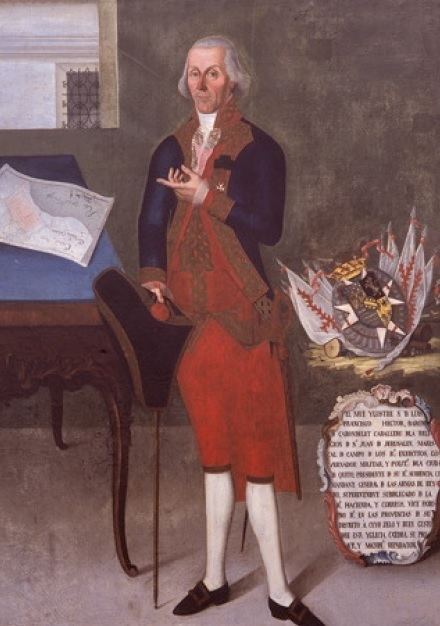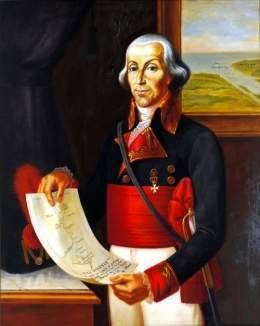Died 1807Quito, Ecuador | Awards Order of Malta Name Francisco Hector | |
 | ||
Occupation Spanish military officer; Governor of Louisiana and West Florida, Governor of El Salvador, President of the Royal Audiencia of Quito Spouse(s) Maria Concepcion Castanos y Aragorri Parent(s) Jean Louis de Carondelet and Marie Angelique Bernarde de Rasoir | ||
Francisco Luis Hector, barón de Carondelet (born 1748, Noyelles-sur-Selle, Flanders – died 1807 Quito, Ecuador) was an administrator of Burgundian descent in the employ of the Spanish Empire. He was a Knight of Malta.
Contents
Youth and military career

Carondelet entered the service of the King of Spain in 1762, at age fifteen. By 1783, he commanded the IV Division, which fought at the Siege of Pensacola in 1783. Upon his return to Spain in 1787, he was attached to the Plandes Regimiento, with the rank of Infantry Colonel, and received the Order of Malta. During this period, he married a woman from Aragón whose family was very influential at the royal court, Maria Concepción Castaños y Aragorri.
Governor of El Salvador (1789 – 1791)
Carondelet was named governor of El Salvador in 1789. Because the local indigenous population working in the indigo industry had declined greatly, Carondolet recruited Spanish laborers. Their descendants are among the blonde and fair-skinned people of today's Chalatenango Department.
Governor of Louisiana (1791 – 1797)
After his term as governor of El Salvador ended he was appointed governor of the Spanish colonies of Louisiana and West Florida, from 1791 to 1797. Fluent in French, he was well regarded by the French Creole population. He established Louisiana's first newspaper, Le Moniteur. He made many improvements in the infrastructure of New Orleans, including the Carondelet Canal and the city's first street lighting. The street light tenders (attendants) served as watchmen and de facto municipal police.
About 1793, he granted land near Cape Girardeau, Missouri, to the Black Bob Band of Hathawekela Shawnee.
U.S. expansion
Carondelet became concerned about westward U.S. expansion and was involved in the West Florida Controversy, which concerned the border between West Florida and the United States. He wanted to thwart the American policy of trying to secure unchallenged access to the Mississippi River, a goal which made Spanish colonial officials fear for the independence of Louisiana and New Spain. Working through an alliance with Native American tribes, Carondelet succeeded in thwarting westward American expansion for several years.
However, the U.S. finally gained ratification (1795) of Pinckney's Treaty, also known as the Treaty of San Lorenzo. It established intentions of friendship between the U.S. and Spain and defined the boundaries between the U.S. and the Spanish colonies. The treaty guaranteed the United States navigation rights on the Mississippi River.
Slave code
Upon taking up his post he had to deal with the Mina uprising in the vicinity of New Roads. Having assumed office just after the first stages of the Haitian Revolution, Carondelet was concerned that mistreatment of slaves might provoke additional rebellions in Louisiana; hence, he promptly introduced a slave code giving some protection to the slaves, which prescribed standards for quantity and quality of food and clothing.
This initiative created a certain amount of tension between him and the slaveholders. Carondelet responded by developing a stronger relationship with the slave and free-colored populations. He commissioned 29 free men of color in the militia and was proud of the three companies he formed with soldiers of African descent.
President of the Real Audiencia de Quito (Ecuador) (1799 – 1807)
After his term in Louisiana, Carondelet served as President of the Real Audiencia de Quito from 1799 through his death in 1807, supervising territory including present-day Ecuador, parts of Peru and Colombia. He was known as a moderate person who refrained from the arrogance and arbitrary behavior so often associated with functionaries. In 1803 he assisted the naturalists Alexander von Humboldt and Aimé Bonpland during their visit to Quito. An educated man with progressive interests, he also helped the naturalist and geographer Francisco José de Caldas and the orator José Mejía Lequerica.
In 1803, Indian insurrections took place in Guamote, Columbe and Yaruquies. Carondolet awarded the Cacique de Licán, José Leandro Zepla y Oro, with a position as the Regidor del Cabildo de Riobamba in 1805, for his loyalty during these uprisings. Carondolet improved the road to Guayaquil, and was a patron of the construction of the dome of the Cathedral of Quito. After his death on August 10, 1807, he was interred at the Cathedral.
